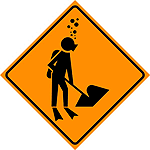|
| |

|
|
| < Prev. month |
Next month > |

|
This page under construction.
Here are some of the topics that will be covered in this chapter. More text and images will eventually be added to this section. Thank you for your patience.
|
- Pickleweed in coastal estuaries turns red in fall, as many other marsh plants begin to die back.
- Geoduck clams settle out of the plankton onto the muddy bottoms of coastal estuaries in September or October. After a brief mobile period, they will dig the burrows where they will spend the rest of their lives.
- Several species of small fish, such as top smelt and arrow goby, live in estuaries throughout the year, but become most numerous in September or October.
- Staghorn sculpin congregate in shallow coastal waters and estuaries, where they will spawn during the winter months.
- Herring enter larger estuaries (especially San Francisco Bay), where they will spawn during winter.
- Bat rays and shovelnose guitarfish leave their breeding areas in protected coastal waters and estuaries. The bat rays gather in the slough in large numbers to give birth in shallow water in early fall, then head offshore before the winter storms arrive.
- Leopard sharks and gray smoothound sharks return to estuaries spend winters feeding first on crabs, then on fat innkeeper worms.
- October and early November are busy times in Central Coast estuaries, as hundreds of thousands of migratory birds stop for a quick rest and a bite to eat. Many of these birds are on their way to Southern California, Mexico or even the coast of South America.
- Some of these migratory birds will stay and spend the winter along the Central Coast. These include least sandpipers, western sandpipers, black-bellied plovers, marbled godwits, willets, curlews, and whimbrels.

|
| |
